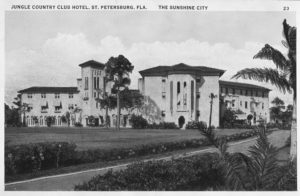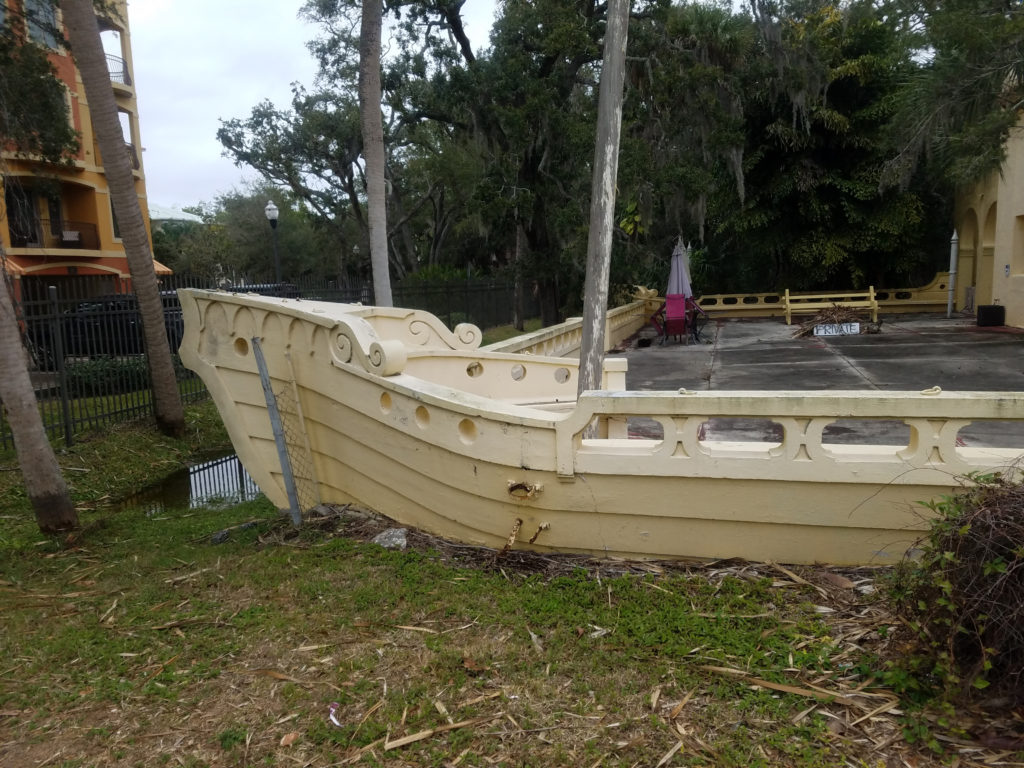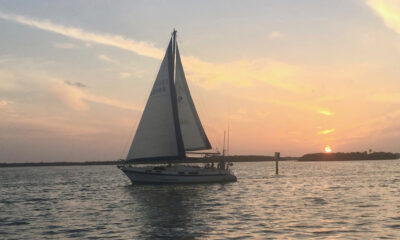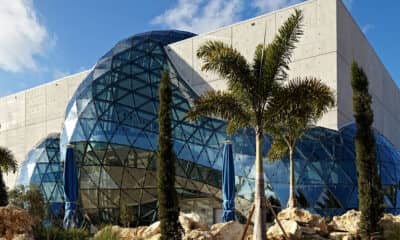Create
VINTAGE ST. PETE: Capone, The Babe, The Gangplank and Jungle Prada

VINTAGE ST. PETE is a weekly series focused on our city’s illustrious (and, sometimes, notorious) past. Many of these features have appeared in the Catalyst over the past two years, and new ones will be added as time goes on. This story was originally published Jan. 25, 2019.
“When the legend becomes fact, print the legend.”
So declared a savvy newspaperman in the film The Man Who Shot Liberty Valance, explaining that once a tale has been repeated over the years it tends to get larger, taking on mythic proportions, until it grows far more interesting than the original truth.
Stories have circulated for nearly a century about Al Capone and Babe Ruth, two famous figures in American history, and their ties to the area of western St. Petersburg known, in different eras, as The Jungle, Jungle Prada and Jungle Terrace.
Capone, the notorious Chicago gangster, and Ruth, perhaps the greatest baseball player of all time, both certainly visited St. Pete in the early 20th century. As a member of the New York Yankees, Ruth was here every spring training season between 1925 and 1934. His exploits in the city – as a beloved and approachable celebrity, a humanitarian and a prodigious consumer of food and liquor – are well documented.

Al Capone
Capone invested in St. Petersburg real estate, and his bootleg alcohol certainly made its way here during Prohibition, but over time the facts of his local connections have been distorted – if not into the stuff of legend, than into some pretty snappy conversation starters.
The Capone and Ruth stories merge at 1700 Elbow Lane North, three narrow and nondescript acres of scrubland between Park Street and Boca Ciega Bay. What is now known as the Jungle Prada Tavern began life in 1925 as a nightspot (and speakeasy) called the Gangplank. It was the first nightclub in St. Petersburg.
“People who come in know there’s a lot of history of the place,” says lead bartender and inventory manager Schawn Williams. “Everybody’s like ‘I heard Al Capone owned this place,’ and a few people bring up what’s supposed to be a mysterious safe.”

“Jungle Prado,” in a 1930s postcard image.
The fact is that the Gangplank was built in 1924, during the Florida land boom, by landowner and developer Walter Fuller. It sat at the Park Street end of a small shopping complex and motel he called Jungle Prado, designed in the Spanish Mediterranean style with high arches, minarets and colorful tile inlays. It was named after Havana’s Paseo del Prado promenade.
At the same time, Capone’s “business partner,” Johnny Torrio, wintered in St. Petersburg – his wife’s family lived here – and engaged in land speculation. He and Capone were shareholders in the Manro Corporation, which bought up approximately 50 acres all over the city, including a large parcel of northern Pass-a-Grille.
According to an Evening Independent story from 1965, Capone spent exactly two days in the city in 1926. Other sources say it was 1927 or 28. It’s not known where he stayed, although it might well have been Fuller’s Jungle Country Club Hotel and golf course, just up Park Street from Jungle Prado and the Gangplank. Torrio was an associate of Fuller’s, and he frequented both the hotel and the nightclub.
Fuller operated a dirt airstrip to the east, at the current site of Tyrone Square Mall. Presumably, this is where the vacationing northern swells – and shady underworld figures – would land before proceeding to his hotel, country club and gin joint.
Writing in the Northeast Journal, historian Will Michaels speculated that Capone might have been in the city again in 1931, before making his way to the sponge docks in Tarpon Springs. The latter visit was documented in the local papers, while there’s only a small, vague mention of the former. “Surely Capone’s arrival would have been a newsworthy event,” Michaels wrote. “With his extensive facial scars he would have been hard not to notice.”
Al ‘Scarface’ Capone, reputed king of Chicago’s gangland, paid a visit to Pinellas County Monday, spending a few hours in St. Petersburg and later motoring to Tarpon Springs, where he spent considerable time looking over the sponge industry. Capone, with a party of five, including one woman, was seen here by several persons. Later in the afternoon, a large crowd gathered at the Sponge Exchange in Tarpon Springs to see the famous baronial head of the beer racket. Capone’s business on Florida’s west coast could not be ascertained, but there was plenty of speculation.
St. Petersburg Times
Feb. 10, 1931
Did Capone have a financial stake in the Gangplank? Probably not. In fact, he likely never set foot in the place. The legend, however, is bolstered by stories of a mysterious underground tunnel leading from the property’s dock, under the fireplace and into the Gangplank bar.
The bay was wild then, and under-patrolled. It would have been a cinch for Capone and Torrio operatives to offload illicit hooch and run it directly into the nightclub, which at its wintertime peak was the center of action for St. Pete’s wealthy visitors. It’s said that both Count Basie and Duke Ellington played the club during its heyday. A trolley ran between the club and Fuller’s three-story Mediterranean Revival style hotel at the corner of 9th Avenue.
Prohibition was a fact – and the tunnel stories, according to Schawn Williams, are true – they’ve been passed down from one lessor to the next (there have been a number of restaurants at the location over the decades). He swears he can hear a hollow sound when he stomps on a certain section of the entryway floor, which has a small, odd slope – and that the restaurant’s current owners were told the city filled them in long ago. He’s never seen an actual tunnel. There is no “hidden entry” beneath the fireplace, as legend has often claimed. At least, not one that Williams can find.
“And I’ve been out there by the bay, looking around for where the entrance might have been,” he explains. He hasn’t been able to locate that, either.

Fuller’s Jungle Country Club Hotel was sold to Admiral Farragut Academy in 1945. The military school sold off the golf course and smaller buildings.
It’s likely, too, that there was another bootlegging tunnel, or tunnels, running under Park Street from the bay to the Jungle Hotel.
In 1970, Fuller confessed – sort of. “I, a nondrinker at the advent of Prohibition became a lawbreaker, a habitual evader of authority, and a steady customer of alcoholic beverages,” he said, according to Michaels. “The first bootlegger I ever saw was me. In such an atmosphere, even the most righteous lacked the courage to speak out, and law enforcers became a lonely and ostracized group.”
As for the “safe,” Williams swears he was told it actually dated from the 1970s, not the Capone/Torrio era, but it disappeared a few years ago – when Jungle Prada Tavern was known as Max and Sam’s … or was it the Saffron’s era?
And since the “Capone-as-part-owner” story has been debunked, opening the safe now would be as anti-climactic as Geraldo Rivera’s live 1986 TV disaster The Mystery of Al Capone’s Vaults.

In this 1931 photo, the Sultan of Swat swats at a golf ball at the Jungle Hotel.
Babe Ruth certainly frequented the Jungle Hotel and its adjacent golf course, and he was known to enjoy certain delicacies at the Gangplank.
Legend: “Babe Ruth got married at the Gangplank!”
Fact: On April 17, 1929, Ruth married Claire Hodgson, his second wife, in New York City. Upon the happy couple’s return to St. Petersburg, so the Babe could report back to spring training, they threw a lavish wedding reception at the club.
Ironically, just across the Jungle Prada Tavern parking lot, there is real, verifiable history. Near the site of the remains of a Tocabago Indian village, Spanish explorer Panfilo de Narvaez and his crew of 300 landed in 1528, and from the spot began Europeans’ first inland exploration of North America.
The Jungle Prada site – encompassing the Narvaez landing site and the adjacent Tocabago mounds – was added to the National Register of Historic Places in 2003.
UPDATE – After this story was published, we heard from Scott Deitche, bay area-based author of several books about organized crime, and an expert on Capone’s activities in St. Pete. He directed us to a 2012 episode of the Discovery Channel series American Treasures, in which the safe – then in the hands of Max & Sam’s owner Craig Malogrides – was opened, on camera.
It was empty.
(The episode is anticlimactic in the extreme – but here’s the link if you’re interested.)

Jungle Prado became an apartment hotel for snowbirds in 1951. Several of the apartments are now privately owned and occupied. Twin concrete “boat prows,” from the earliest days, mark the western edge of the property. This is most likely where the original swimming pool was located. Photo by Bill DeYoung.








Digital Chainsaw
October 12, 2023at2:20 pm
Cool article, except the Tyrone Square Mall property was never part of Piper-Fuller Flying Field, which was entirely west of the Seaboard Air railroad tracks, now the Pinellas Trail.
Digital Chainsaw
October 12, 2023at2:16 pm
That is correct. I lived there in 1993/94 in #108 and the pool was still functional then. The tennis courts were in ruins, as was an old gazebo on the property, but there was a barbeque pit attached to the gazebo we still used from time to time. Sigh… Good times.
Foxy
December 29, 2022at11:32 am
Thanks for this info. I remember when the pool was there, it was just beyond the patio under what is now condos. That was in 2002 so not that long ago.
Roy Christian
July 21, 2020at7:33 pm
I have a letter typed by Babe Ruth while he was at the Jungle resort during spring training. Signed and authenticated.. cool history.
Don Grzeb
April 8, 2020at7:14 am
I live near Capone’s joint & would like to learn of other things in the area..m
BRIAN WEEKS
April 4, 2020at3:57 pm
Don’t forget- Babe Ruth and Lou Gehrig also had apartments at the infamous Flori de Leon Apartments at 130 4th Avenue North, where The Babe had a special elevator installed to bring his “ladies” up to his 7th floor apartment! A few years later, when Lou became ill, The Babe switched apartments so that his sick friend would have the elevator for his comfort.